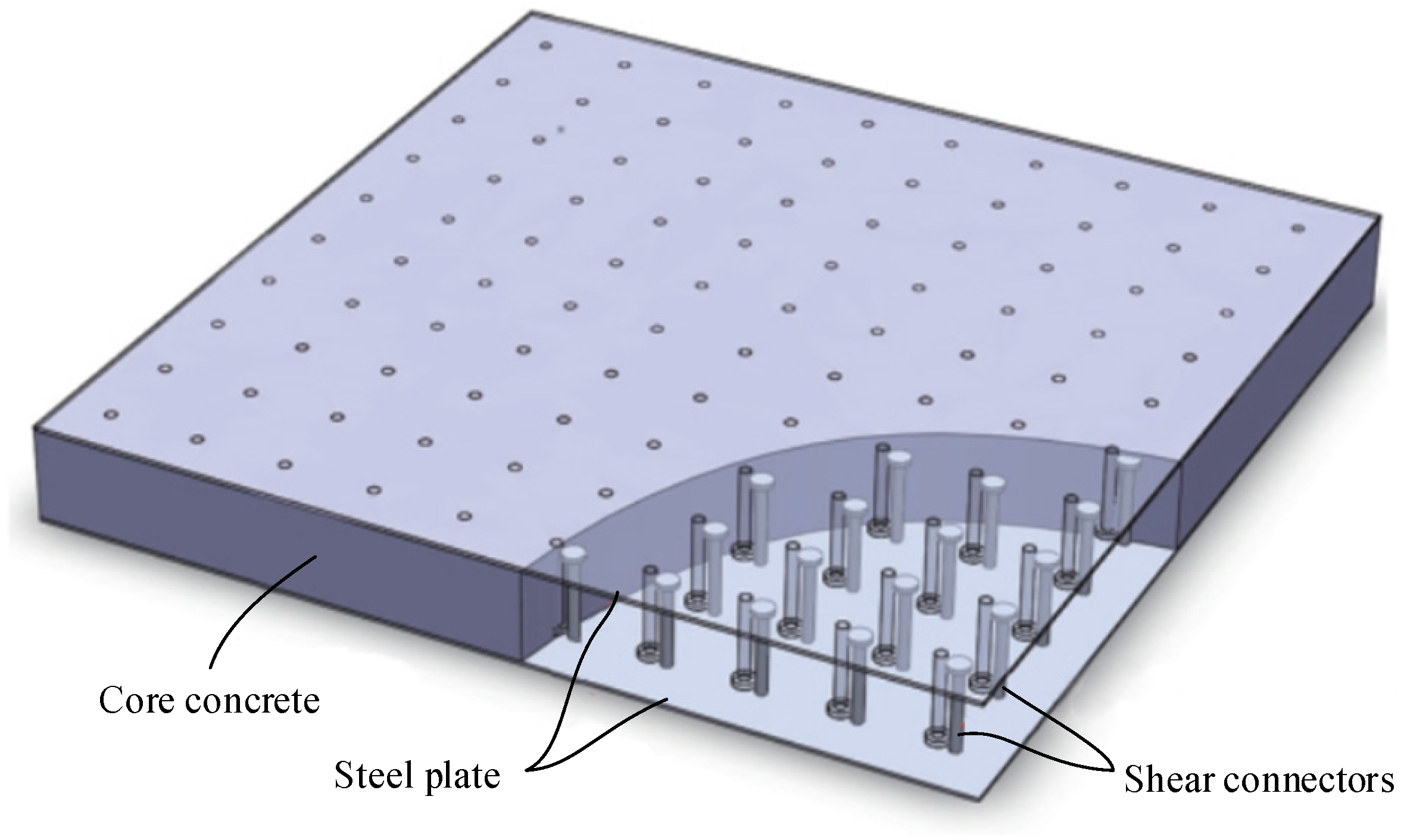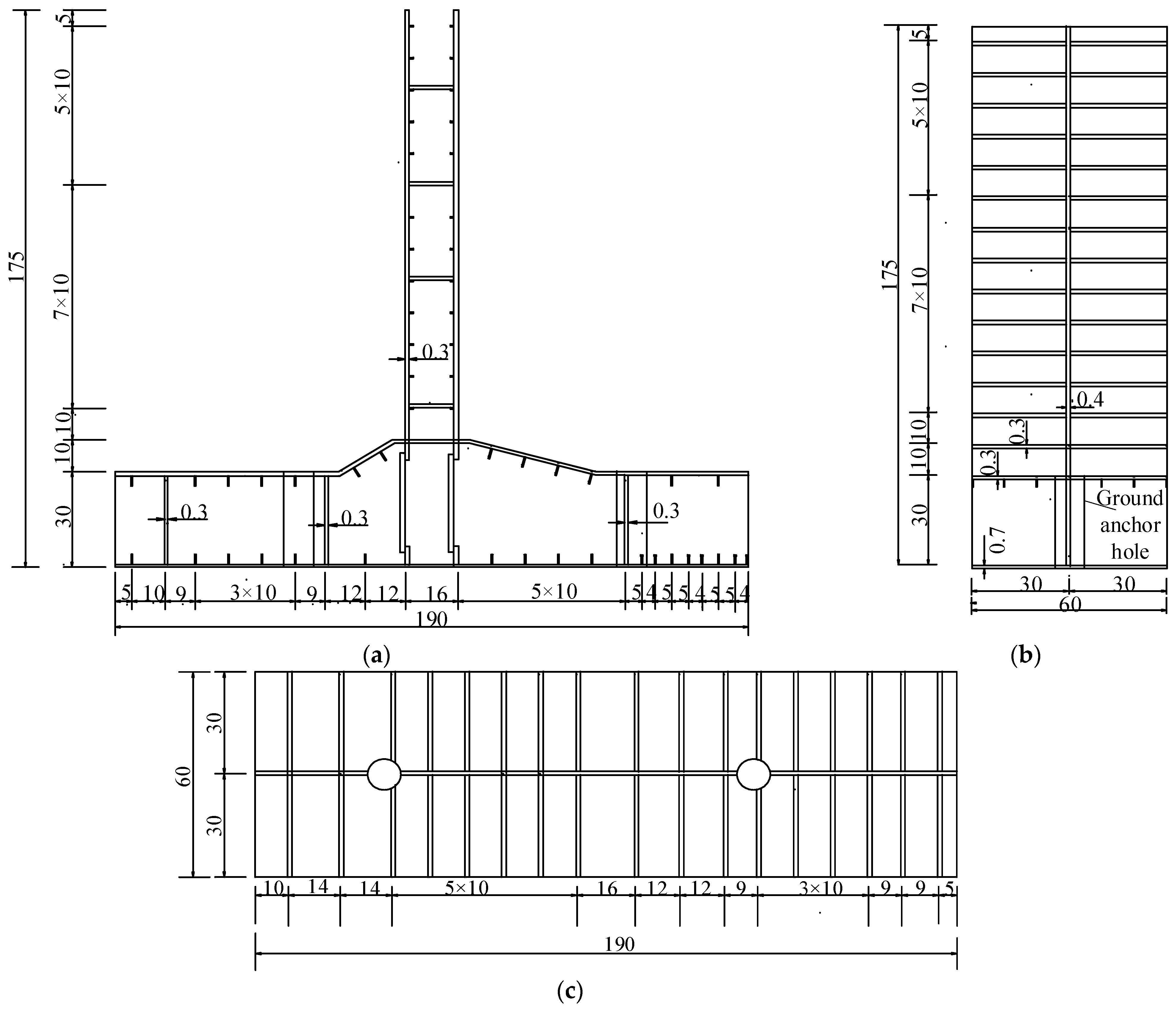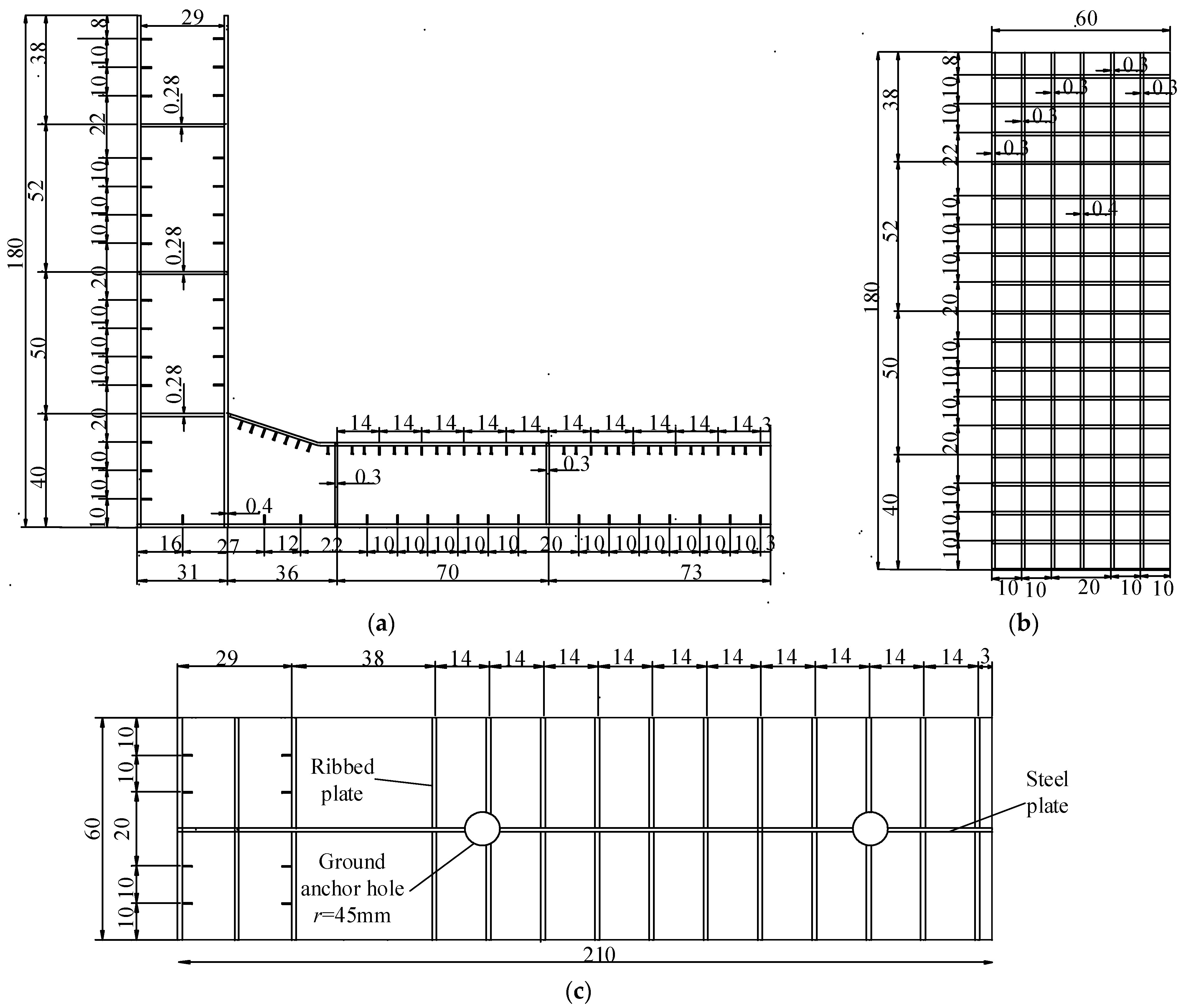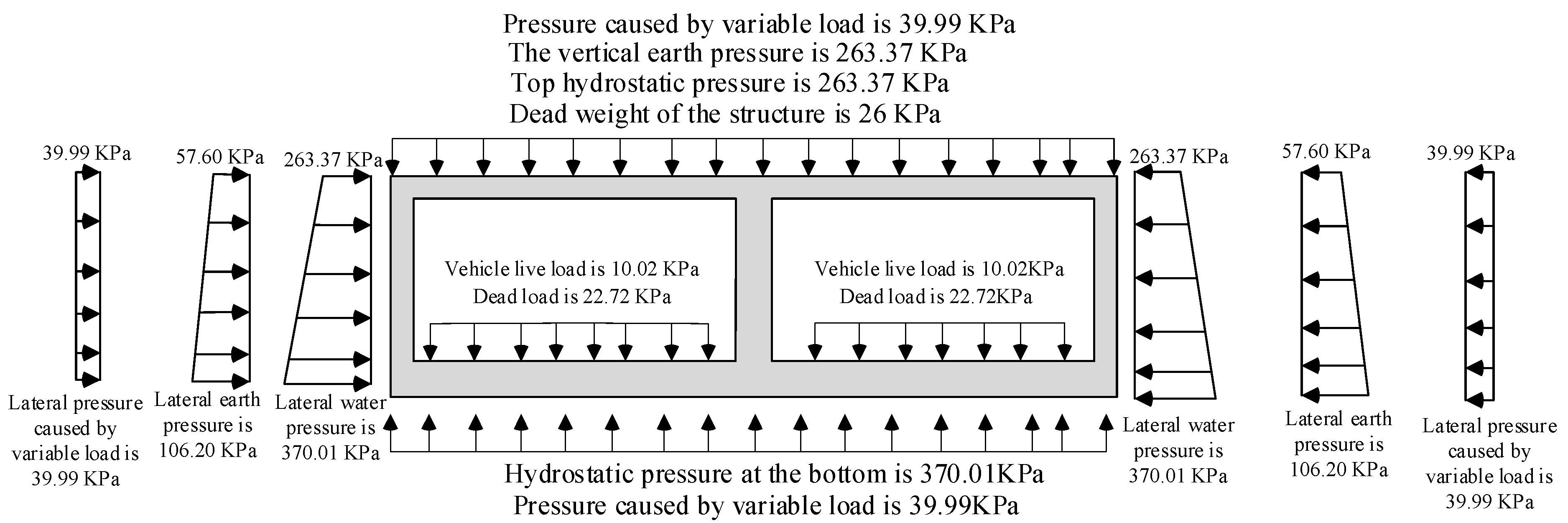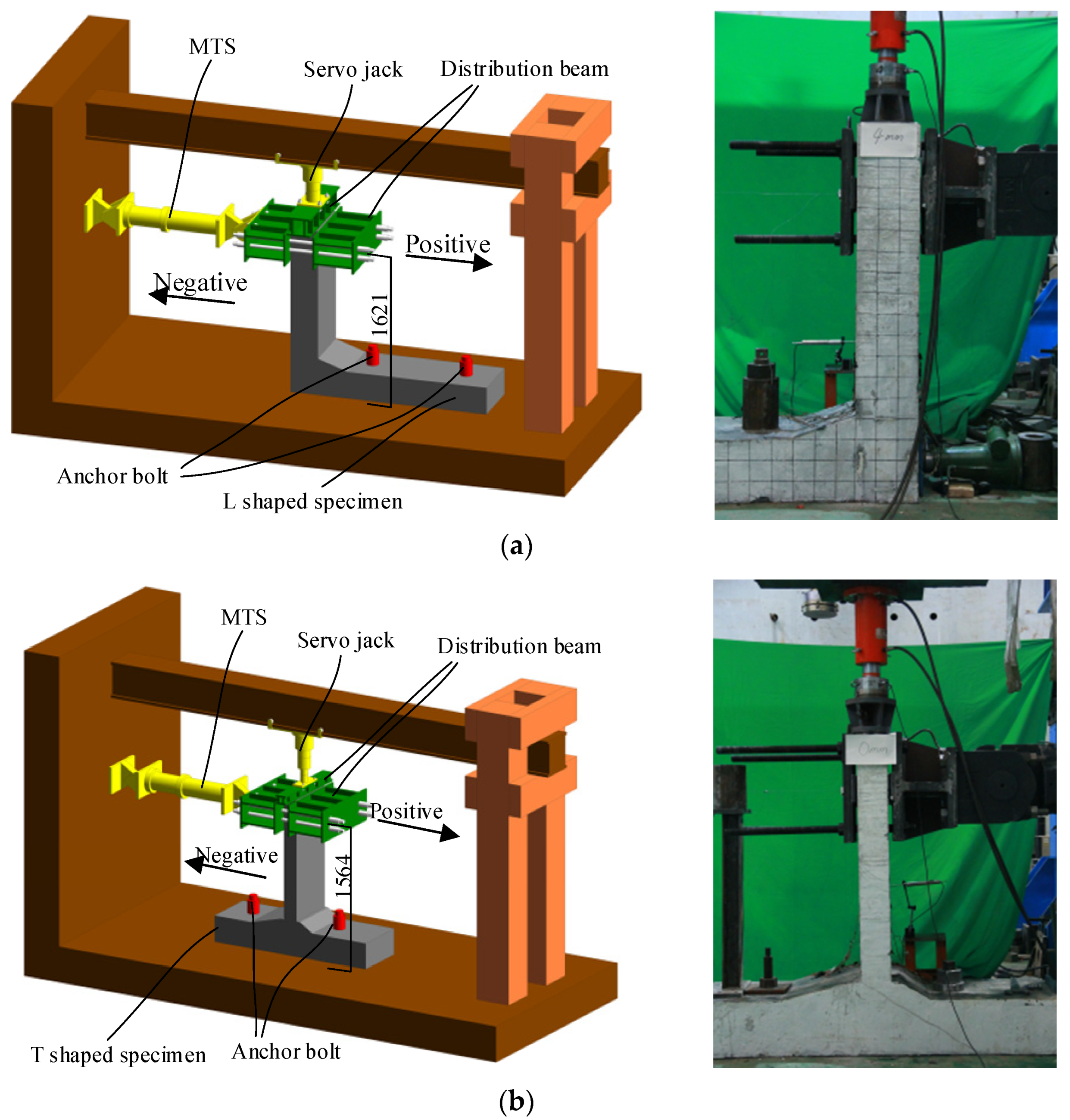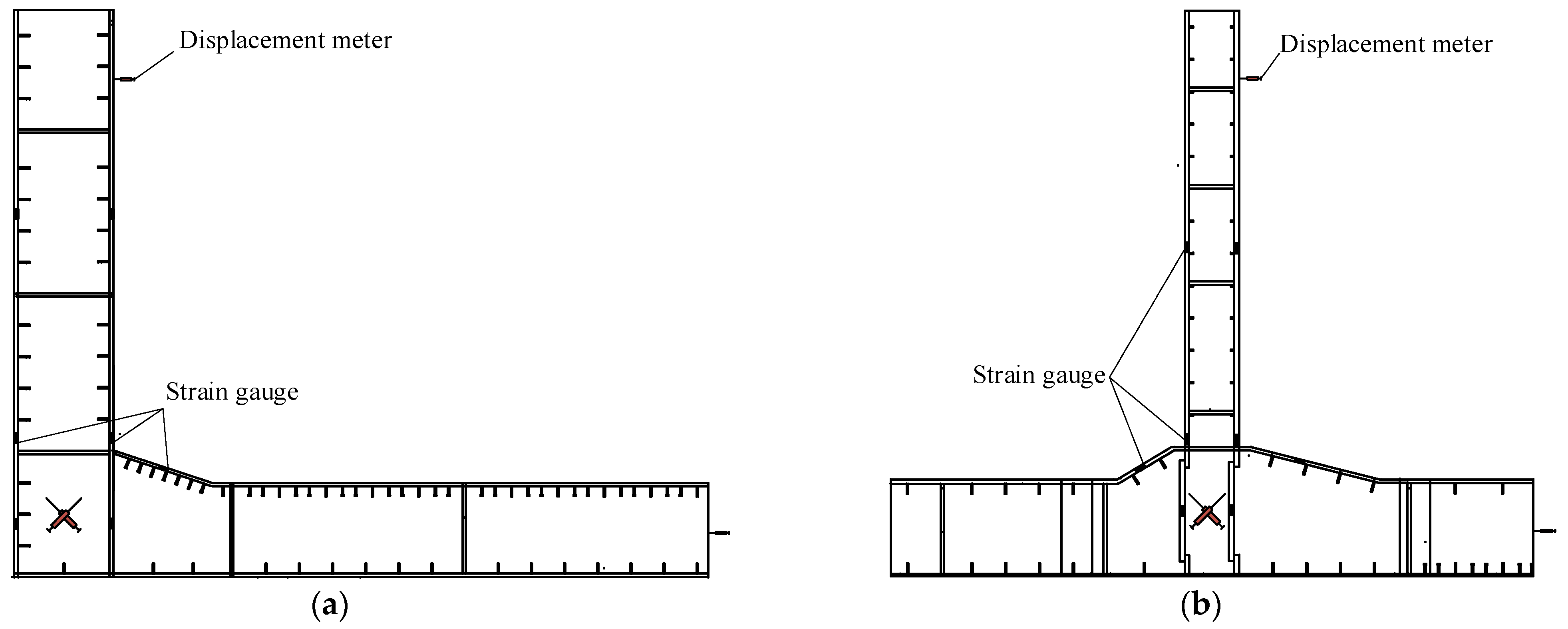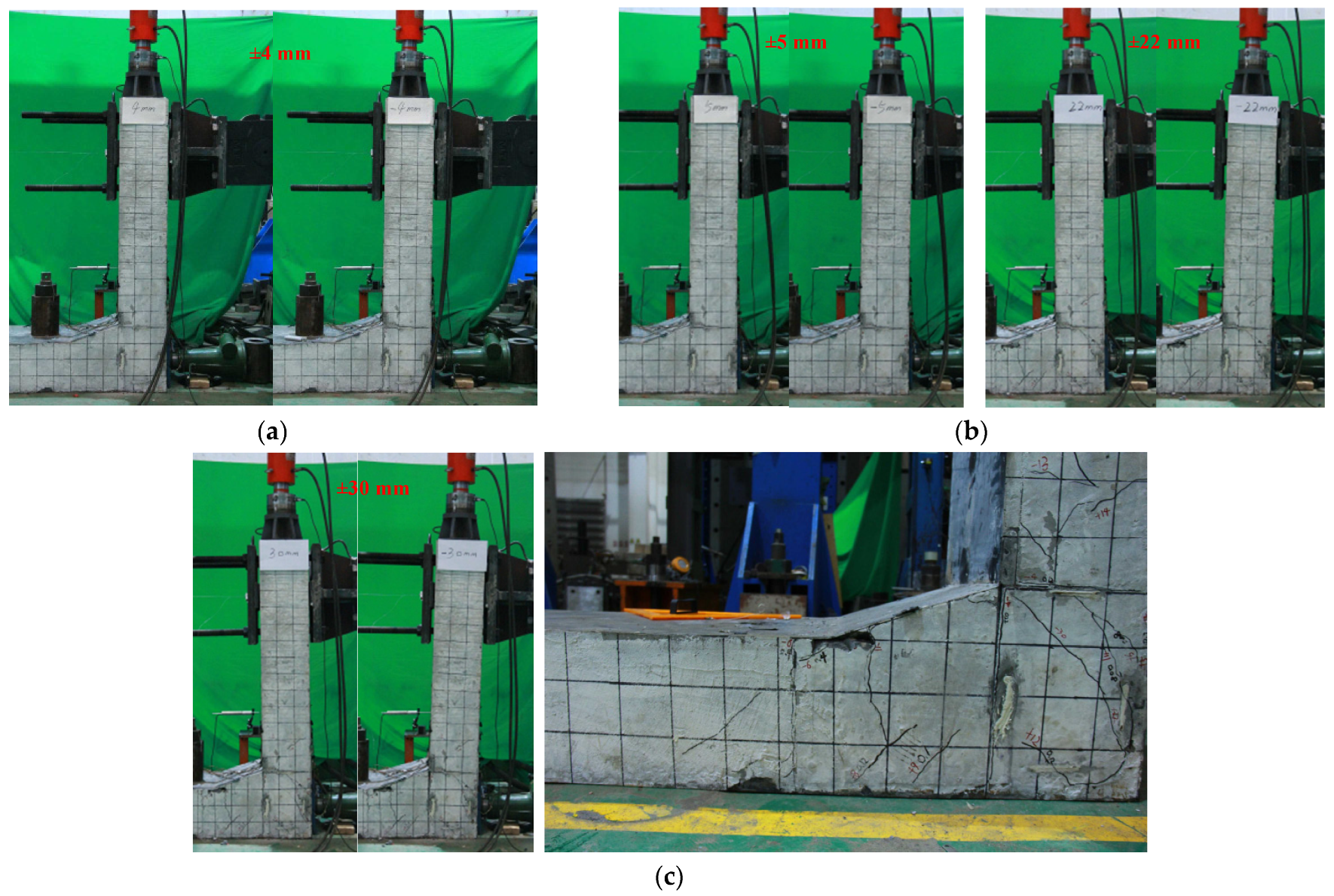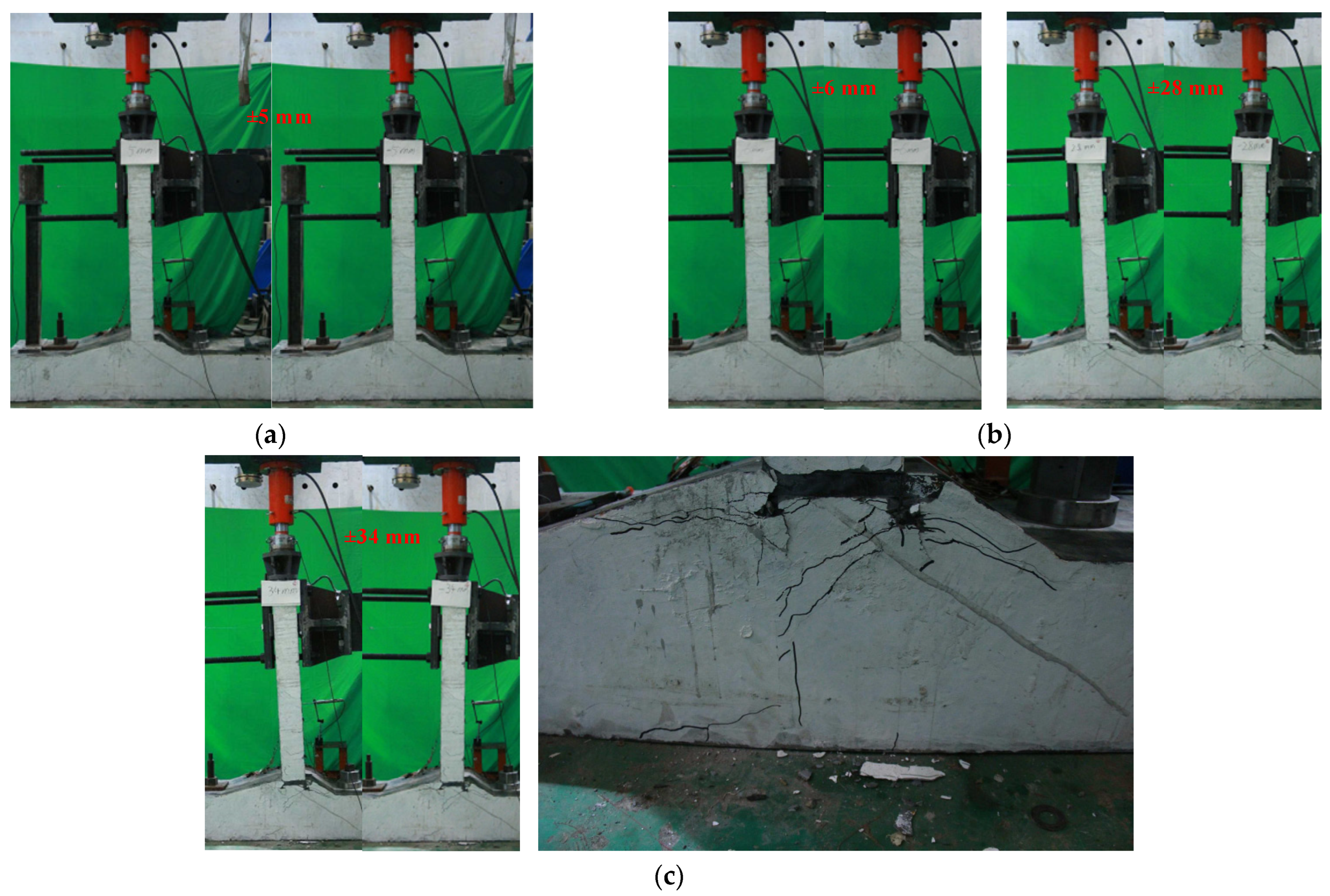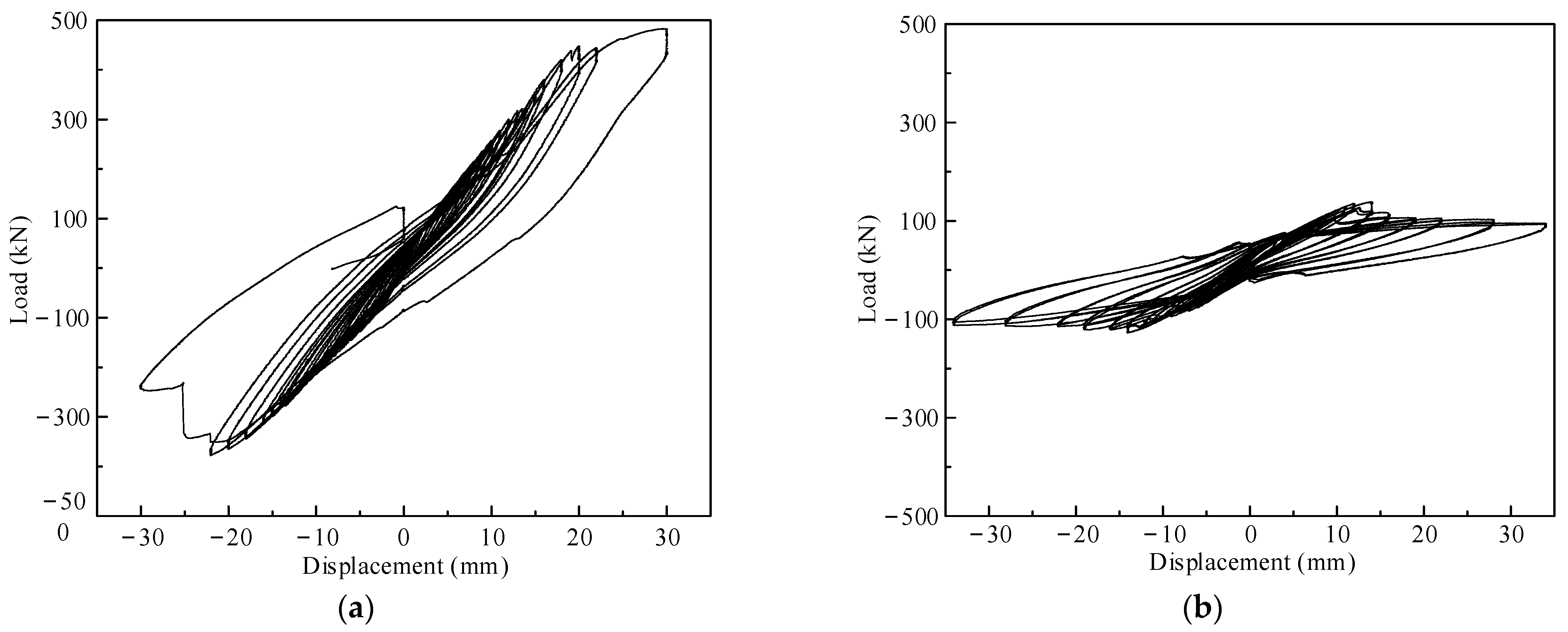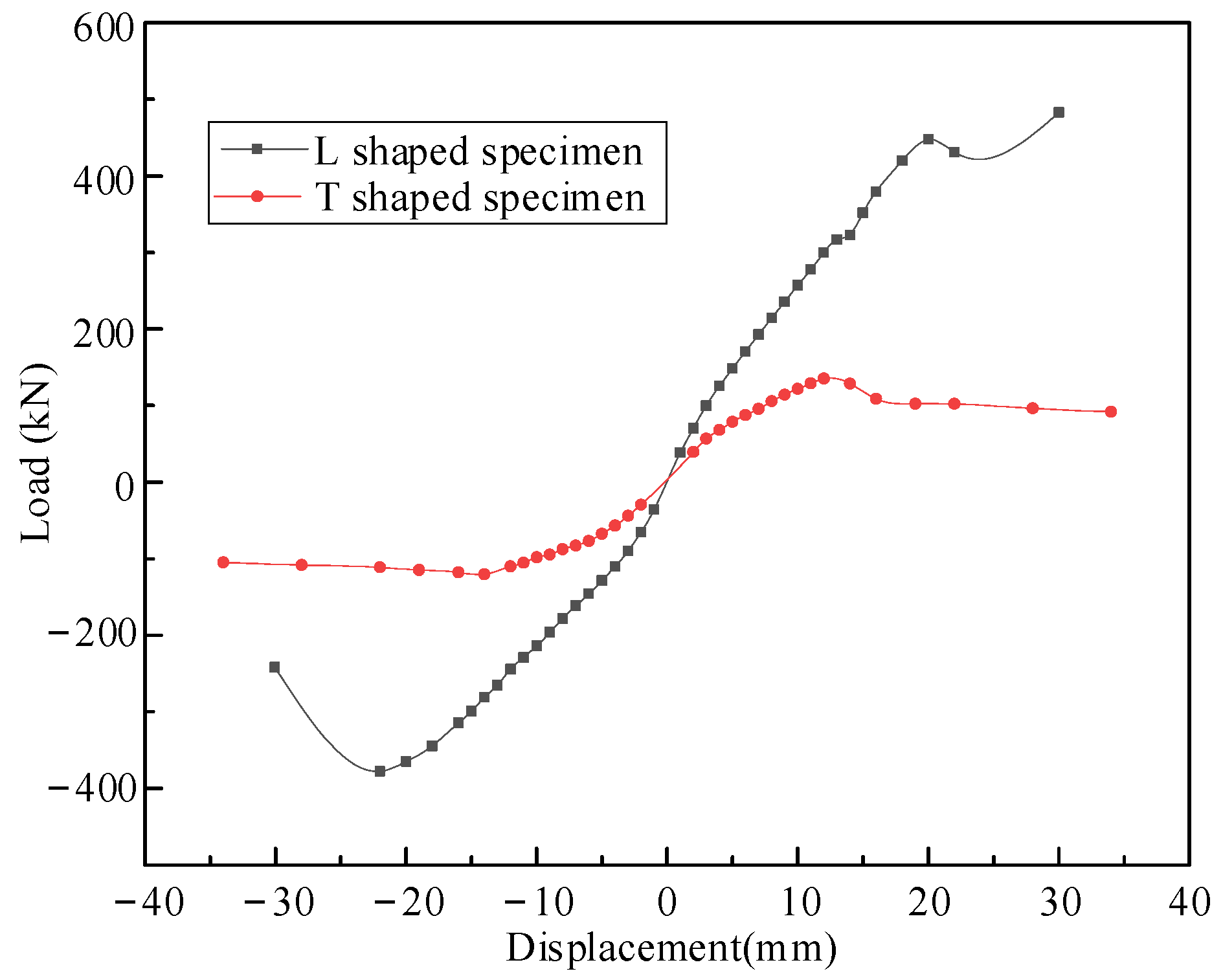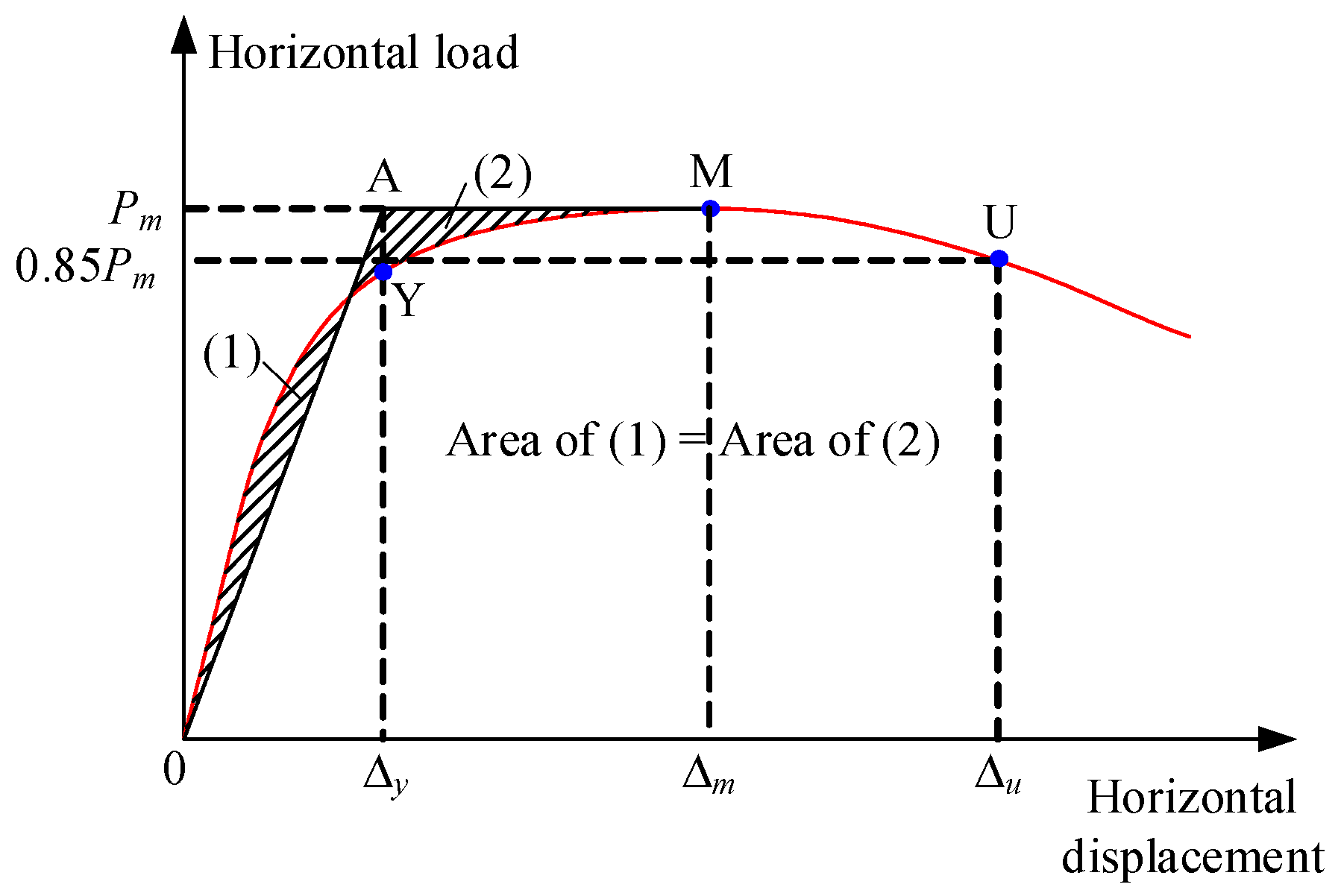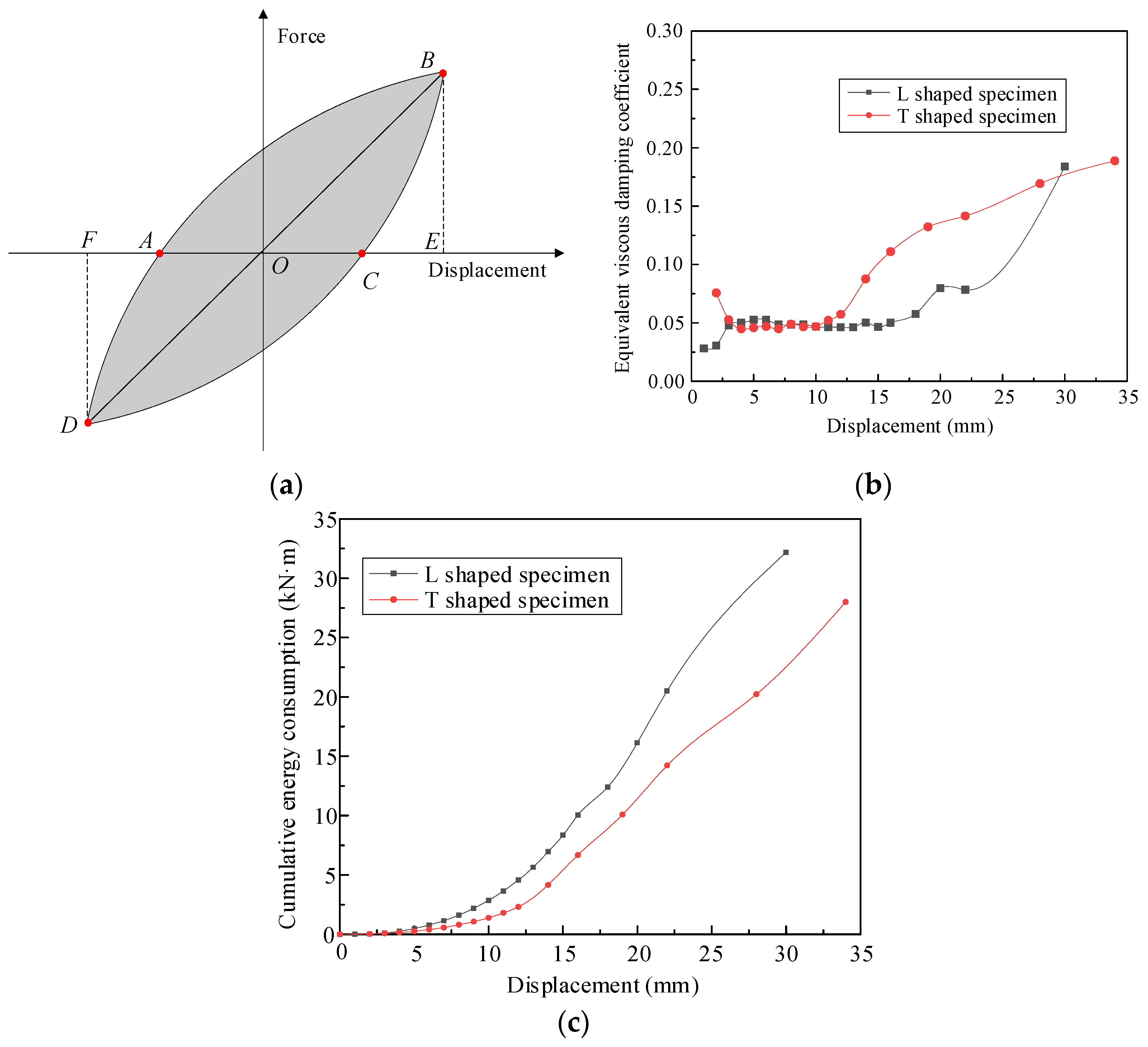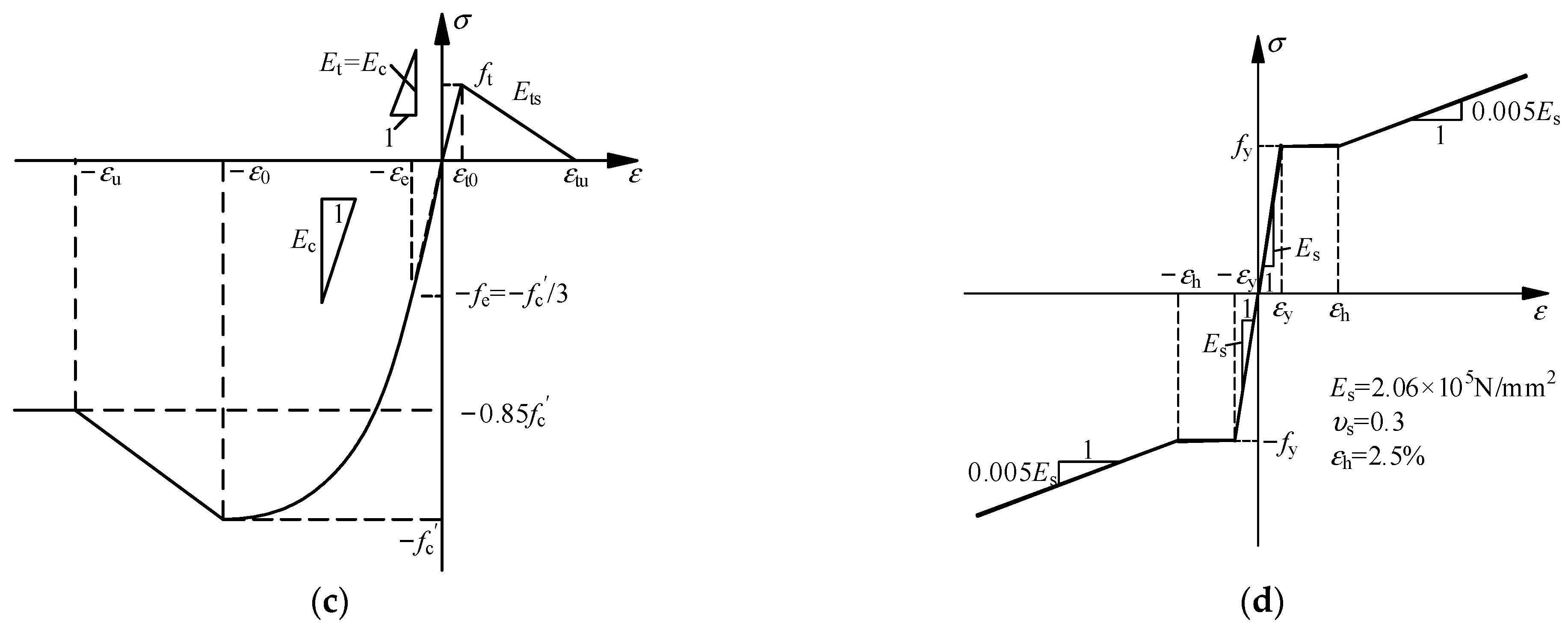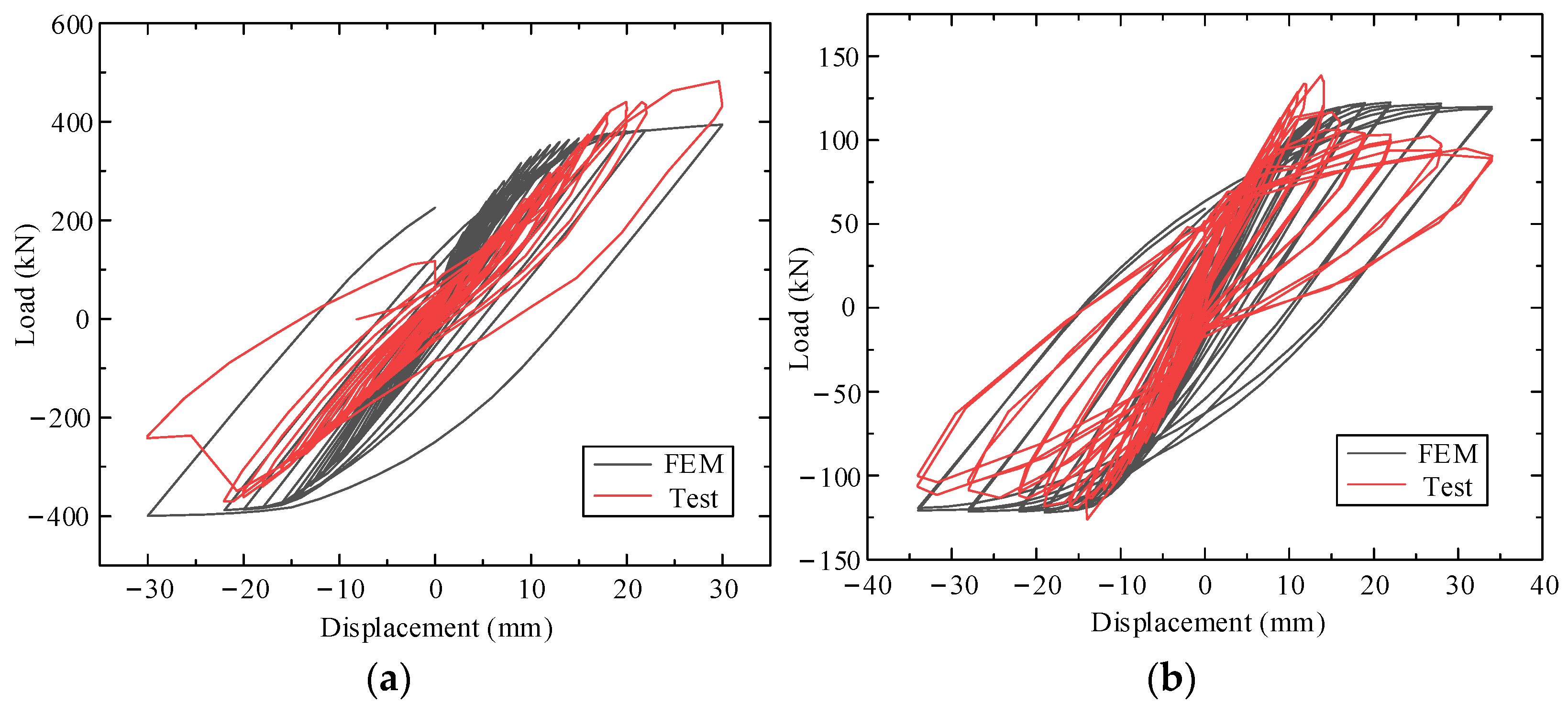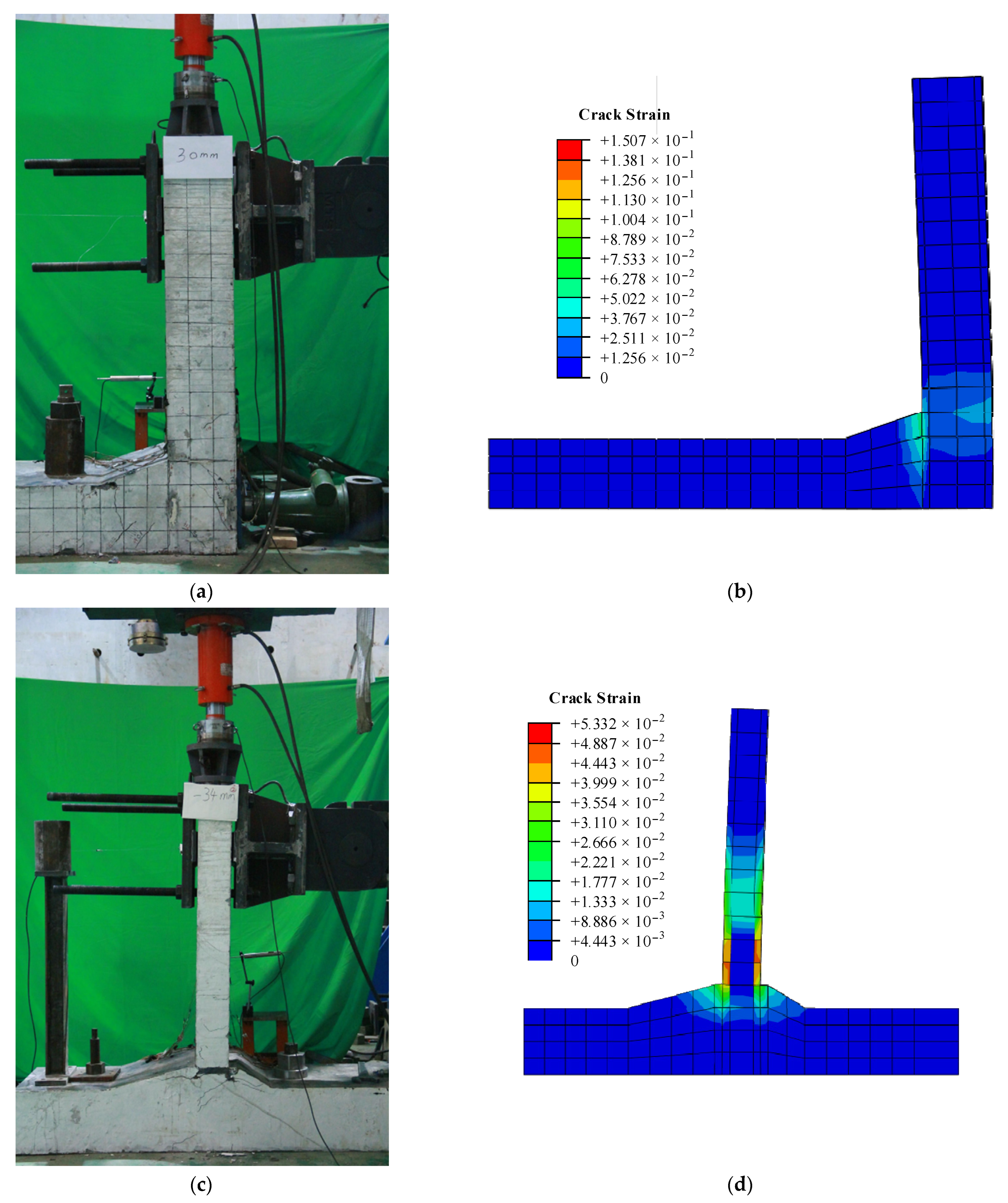1. Introduction
Due to the good mechanical properties of the double steel plate–concrete combination structure, it has been used in a large number of applications, including in marine structures, nuclear structures and some other protective structures. Moreover, part of the tunnel structure also uses a double steel plate–concrete combination structure. At present, many studies have been conducted on the mechanical properties of the double steel plate–concrete structure, but research on its seismic performance is still lacking.
In the construction of an immersed tunnel, a number of prefabricated pipes are floated to the site, which sink one by one, and then the connection between the pipes in the water is completed. Finally, the construction of related works is carried out so that these pipes form a whole to become a tunnel-type transportation carrier for land traffic at both ends of the water body [
1]. Immersed tube tunnels work well in areas with poor foundation conditions, especially in areas where soft foundations, riverbeds or seabeds are shallow and easy to excavate with water-based dredging equipment. The main structural forms of immersed tube tunnels are reinforced concrete structures, steel shell structures and steel–concrete combination structures [
2]. Steel shell immersed tube tunnels emerged in the United States, and reinforced concrete immersed tube tunnels emerged in Europe [
3]. The world’s first immersed tube tunnel for traffic was the Detroit River Railway Tunnel in the United States in 1910, which used a steel shell structure. Subsequently, almost at the same time, the two countries of Britain and Japan built on the basis of these two technologies and proposed a double steel plate–concrete combination immersed tube tunnel, also known as a sandwich steel mixed combination immersed tube tunnel, and Japan applied this technology to the construction of an actual tunnel project [
2].
A double steel plate–concrete composite structure is a new high-performance composite structure [
4]. In foreign countries, it is known as an SCS composite structure (steel–concrete–steel composite structure) or DCS composite structure (double skin composite structure). In China, it is sometimes called a steel plate composite structure. The composition of this structure is shown in
Figure 1 [
5]. Usually, the shear connectors are first connected between the two clad steel plates and installed in place on both sides of the steel plate, and, finally, the concrete is filled inside the two sides of the steel plate so that the clad steel plate and the core concrete (high-performance concrete and ordinary concrete) can be closely combined through the pegs, thus forming a combination of high shear strength structural systems. This structure can make full use of the material properties of concrete and steel [
6]. Under load, the internal concrete is in a three-direction stress state with enhanced strength and plasticity, while the outer clad steel plates do not buckle prematurely under the tension of the shear connectors and the support of the concrete. Hence, this structure has the advantages of high strength, high stiffness, good ductility, good impact resistance and good construction efficiency.
Research on double plate-concrete composite structures started in the 1970s and can be broadly divided into two directions: wall elements [
7], which are usually monolithic, T-shaped and L-shaped shear walls of buildings and are mainly related to in-plane performance, and beam elements, which are generally used for marine elements, protective structures and tunnel structures [
8] and are mainly related to out-of-plane performance. In 1975, Montague [
9] developed a double steel plate–concrete combination structure oil storage cylinder for oil extraction and storage in the North Sea. In 1976, Solomon et al. [
10] proposed a double steel plate–concrete combination structure with structural adhesive bonding at the steel-mixed interface for large- and medium-span bridge panels. In 1977, to improve the performance of traditional reinforced concrete (RC) structures or prestressed concrete (PC) structures under the combined effects of temperature, internal pressure and strong bottom restraint, Ichikawa et al. [
11] proposed the use of a double steel liner as the containment structure for nuclear power plant buildings. In the early double steel plate–concrete combination structure, the steel plate and concrete mainly relied on the interfacial bonding force between them to work together, and the force was prone to slip damage. Later, to optimize the design, shear joints were gradually used in the steel–concrete combined structure, and the addition of shear joints led to a substantial improvement in the structural integrity and stiffness. In 1986, Tomlinson et al. [
12] proposed an overlapping pinned double steel plate–concrete combined structure form in the Welsh Trans-Conwy River immersed tunnel project. Subsequently, a large number of studies on sandwich structure immersed tube tunnels were carried out in the UK [
13], 1:3 physical model experiments were conducted and the British Steel Construction Association developed a design code for double steel plate–concrete combination structures in 1994 [
14], but no actual projects of sandwich structure immersed tube tunnels were subsequently built. In 1988, Japan proposed a combination of steel shell, bulkhead, ribs and inner filling. In 1988, Japan proposed a compartmentalized double steel plate–concrete combination immersed tube structure with a combined layer of concrete and built sandwich steel–concrete combination immersed tube tunnels, such as the Kobe Port Island Tunnel (1999), Naha Tunnel (2011) and New Wakato Tunnel (2012). The proposed completion of the Deep China Passage in 2024 is the first time in China that a new steel shell–concrete combined structure of an immersed tube tunnel was implemented, and it adopted a steel shell immersed tube design similar to the “sandwich” structure.
The above studies show that, with the further development of marine structures, nuclear structures, protective structures and tunnel structures, a large number of research reports related to double steel plate–concrete combined structures have appeared at home and abroad. However, since the actual number of tunnels built with double steel plate–concrete combined structures is quite small, and their structural systems are not as clear and explicit as reinforced concrete or steel structures, some mechanical performance indicators of structural immersed tube tunnels still need to be verified. Therefore, based on a deep-medium immersed tube tunnel project, this paper carries out research related to the seismic performance and damage mechanism of steel-shell–concrete-structure-immersed tube tunnel nodes under earthquake action.
3. Analysis of Experimental Results
To study the seismic performance of immersed tunnel nodes of steel shell–concrete structures, this paper relies on actual projects—designs of L- and T-shaped reduced-scale specimens of an immersed tunnel—and completes the proposed static test loading. The main results of the tests are provided in this section, including the observation of damage phenomena, load–displacement hysteresis curves, skeleton curves and cumulative hysteresis energy dissipation. Based on the observations of structural deformation and crack distribution under all levels of loading, the damage mechanism of immersed tunnel nodes under earthquake action is analyzed. Further analysis of the load carrying capacity, ductility, deformation and energy dissipation capacity of the immersed tunnel nodes is carried out using the measured structural load–displacement curves.
3.1. Damage Observation
To accurately capture the damage process of the specimens and clarify the damage mechanism, the crack development and distribution on the surface of the members were observed by the crack observer at the end of each loading level. The observed crack distribution of the L-shaped and T-shaped nodal specimens at the end of each loading level is presented in
Figure 9 and
Figure 10.
For the L-shaped node specimen, the specimen showed no cracks when the displacement of the loaded end increased from 0 to 4 mm. When the lateral displacement increased to 5 mm, a microcrack along the vertical through-length was produced in the core area of the node near the axillary corner position, and the crack width was 0.22 mm, accompanied by slight noise from the deformation of the steel plate. With a further increase in load, the cracks in the core area further developed, and several diagonal cracks appeared near the location of the bottom plate. At the same time, transverse tension cracks appeared in the concrete at the upper part of the axillary angle and gradually developed along the through-length. When the lateral displacement reached 13 mm, concrete spalling occurred near the lower part of the axillary angle. At the same time, transverse tension cracks appeared at the position of the vertical wall approximately 20 cm above the height range of the core area. As the load increased, the cracks developed further, and the concrete kept spalling off from the surface of the specimen, accompanied by a loud sound from the deformation of the steel plate. The lateral displacement increased from 22 mm to 30 mm, and oblique cracks appeared in the lower right corner of the bottom slab and gradually developed and penetrated along the core area. The lateral displacement reached 30 mm, the steel plate and concrete fell off in the axillary corner and core area and the structure cracked significantly. The analysis concluded that the steel plate and concrete could not work together at this time: the structure failed and showed brittle damage characteristics.
For the T-node specimen, the lateral displacement increased from 0 to 5 mm, and no obvious cracks were observed on the surface of the member. The lateral displacement increased from 6 mm to 9 mm, and transverse bending cracks appeared on the face parallel to the loading direction at the vertical wall position and gradually propagated upward, accompanied by a slight noise from the deformation of the steel plate. With increasing load, the cracks in the core area of the node developed continuously. The lateral displacement increased from 16 mm to 22 mm, the width of the crack in the core area further increased and the bending crack at the location near the axillary corner gradually developed to pass along the lateral length. At the same time, the concrete located at the upper corner point of the core area showed slight spalling. The lateral displacement reached 28 mm, the concrete cracking width at the position where the vertical wall intersected with the axillary angle further increased and the concrete on the surface of the member kept spalling. When the lateral displacement reached 34 mm, a large amount of concrete spalling occurred on the surface of the core area, and the steel plate at the intersection of the vertical wall and the axillary angle was peeled off from the concrete, accompanied by a large noise from the structure. At this time, the lateral bearing capacity of the member dropped to 85% of the peak bearing capacity, and the structure failed. From the loading test results, it can be seen that, under the action of reciprocating loading, the T-node specimen underwent more favorable bending damage.
3.2. Load–Displacement Curves
The load displacement curves of the L-shaped and T-shaped nodal specimens are provided in
Figure 11. As shown, it can be seen that the L-shaped specimen exhibits better mechanical properties. At the same displacement level, the lateral bearing capacity of the L-shaped specimen is higher than that of the T-shaped specimen. Additionally, the larger envelope area of the load–displacement curve of the L-shaped specimen implies a higher energy dissipation capacity of the member, which may be due to the larger value of the vertical wall thickness of the L-shaped specimen (300 mm versus 160 mm). The measured load–displacement curves of the T-shaped specimens have good symmetry compared to those of the L-shaped specimens, which is consistent with the geometry of the specimens and the configuration of the steel plates having symmetrical characteristics. In addition, the results show that the hysteresis curve of the T-shaped specimen has a good pinching effect, and the load–displacement curve of the L-shaped specimen shows significant asymmetry in the loading direction. Moreover, the positive load carrying capacity (push) is significantly higher than the negative load carrying capacity (pull) along the loading direction. This is mainly caused by the asymmetry of the specimen geometry and steel plate configuration. At the end of reverse loading, the lateral bearing capacity of the L-shaped specimen decreases sharply, which is a brittle damage type and consistent with the damage characteristics of the test where the steel plate and concrete are detached and the two cannot be stressed together, and the structure fails due to the loss of integrity.
3.3. Skeleton Curves
To further explore the mechanical properties of the members, the skeleton curves of the L- and T-shaped specimens are provided in
Figure 12. When the load–displacement curve of the structure corresponds to a point where the load value drops to 85% of the peak load, the structure is considered to be damaged. In this study, the yield displacement of the frame is determined based on the method of equivalent elastic–plastic energy absorption [
20], and the relevant calculation sketch is shown in
Figure 13. First, an inclined line is drawn from the origin and intersects the horizontal line drawn past the peak point
M. The intersection point is denoted as
A and makes the area of the two shaded parts provided in
Figure 13 equal. Then, a vertical line is made through point
A, and the intersection with the skeleton curve is recorded as
Y. The intersection point
Y is the equivalent yield point, and the corresponding displacement and load are the equivalent yield displacement and load, respectively. From the determined equivalent yield point and skeleton curve, the equivalent yield displacement, equivalent yield load, peak load, ultimate displacement and ductility coefficient of the member are calculated. It should be noted that the above parameters are calculated in two loading directions, positive and negative, and the results are shown in
Table 2.
As observed from the above table, the mechanical properties of the T-shaped specimens exhibit good symmetry, while those of the L-shaped specimens exhibit more obvious asymmetry. For the L-shaped specimen, the peak bearing capacity values along the positive and negative loading directions were 447.74 kN and −377.63 kN, respectively, with a difference of 18.57%. The reason for this difference is the asymmetry of the geometry and steel plate configuration of the L-shaped specimen. In addition, compared with the L-shaped specimen, the T-shaped specimen has better ductility but lower lateral load capacity. The analysis suggests the following possible reasons: (1) the L-shaped specimen has nonuniform damage and strength degradation in two different loading directions during loading due to the asymmetry of the geometry and steel plate arrangement; (2) the L-shaped specimen has a larger value of vertical wall thickness compared with the T-shaped specimen. In contrast, the T-shaped specimens had larger ultimate deformation values (34 mm versus 30 mm) when the specimens underwent damage. Therefore, in the actual project, the mechanical properties of the immersed tunnel structure will be controlled by the L-shaped nodes, which also coincides with the test observations of the node tests.
The ductility coefficient of the T-shaped specimen is 4.91 along the two different loading directions, while the ductility coefficient of the L-shaped specimen is 2.05. The L-shaped node of the immersed tube tunnel is vulnerable to damage when an earthquake occurs, which should be considered in engineering practice. The negative bearing capability of the L-shaped node needs to be enhanced. Some measures can be taken to achieve the results, such as strengthening the connection between the steel and concrete, enhancing welds near the core area and axillary corner and adding connectors between steel partitions and concrete within the tunnel.
3.4. Dissipation of Energy
It is well known that the area of the hysteresis loop envelope represents the energy dissipated by the structure during the reciprocal loading process. Currently, there are two important parameters commonly used to measure the energy dissipation capacity of a structure: the cumulative structural energy dissipation value and the equivalent viscous damping coefficient. The former refers to the cumulative energy dissipated by the structure after each level of loading, while the latter represents the ratio of the total energy dissipated by the structure to the total elastic potential energy stored in the structure during a loading cycle. For a typical hysteresis loop, as shown in
Figure 14a, the equivalent viscous damping coefficient can be calculated using the following equation [
21,
22,
23,
24,
25,
26]:
In the above equation,
AABCD refers to the area of the closed figure enclosed by the hysteresis loop and the energy dissipated by the structure in one loading cycle, and
AOFD +
AOBE refers to the sum of the areas of the triangles
OFD and
OBE, representing the total elastic potential energy stored in the structure. Based on the above defined equations, the curves of the cumulative energy dissipated and the equivalent viscous damping coefficient relative to the displacement change for the L-shaped and T-shaped specimens are calculated as shown in
Figure 14b. The displacements marked in the figure are obtained by first taking the absolute values of the displacements at the forward and reverse loading ends under each level of loading and then summing them and taking the average value.
As shown in
Figure 14c, the cumulative energy dissipation of each specimen increases approximately exponentially with the displacement at the loading end. With increasing loading displacement, the damage to the structure accumulates, and plastic deformation fully develops, which leads to a gradual increase in the energy dissipation of the members. In addition, the cumulative energy dissipation of L-shaped specimens was larger than that of T-shaped specimens at the same displacement level, which was mainly due to the relatively larger value of the vertical wall thickness of L-shaped specimens (300 mm versus 160 mm).
As shown in
Figure 14b, the equivalent viscous damping coefficients of the specimens increased monotonically with increasing loading end displacement. At the beginning of the test, the difference between the equivalent viscous damping coefficients of the L-shaped and T-shaped node specimens is small. After the displacement of the loaded end exceeded 10 mm, the T-shaped specimen had a larger equivalent viscous damping coefficient than the L-shaped specimen at the same displacement level. Therefore, it can be assumed that the T-shaped specimen has better ductility than the L-shaped specimen after the structure enters the plastic phase. The L-shaped specimen is an asymmetric structure. During the test, the specimen did not reach the ultimate state when it was positively loaded, which was significantly lower than that of the T-shaped specimen when it was loaded negatively. The reason for the results is that the axillary corner and the core area of the L-shaped specimen are subjected to large stresses, producing brittle damage. While the T-shaped specimen wall is weaker, it is more likely to develop plastic deformation at the boundary of the wall bottom and the axillary corner. The equivalent viscous damping coefficients of the L-shaped and T-shaped specimens are 0.18 and 0.19, respectively, when structural damage occurs.
5. Conclusions
This paper focuses on the experimental and numerical study of the mechanical properties of immersed tunnel nodes in steel shell–concrete structures. The paper designs and fabricates L- and T-shaped node specimens with a scaled-down ratio of 1:5. The tests adopt a proposed quasi-static loading scheme to study the seismic performance and damage mechanisms of the immersed tunnel nodes of steel shell–concrete structures under earthquake action. In addition, a rigorous numerical model of the nodal specimens based on ABAQUS is established in this paper.
(1) In the damage stage, the concrete and steel plates in the core area of both L-shaped and T-shaped specimen nodes were severely peeled. Among them, the crack development in the core area of the L-shaped specimen node is not obvious, and, in the ultimate load stage, the bearing capacity of the specimen decreases sharply, showing the characteristics of brittle damage. In contrast, the cracks in the core area of the T-shaped specimen node were fully developed, and the concrete spalling was serious, showing more favorable bending damage.
(2) The test results show that the L-shaped specimen has a higher lateral bearing capacity and energy dissipation capacity, which may be due to the larger value of the vertical wall thickness of the L-shaped specimen (300 mm versus 160 mm). The equivalent viscous damping coefficient of the T-shaped specimen is higher than that of the L-shaped specimen at the same displacement level, indicating that the T-shaped node has better ductility. Therefore, in engineering practice, local strengthening of the outermost vertical wall should be carried out to improve the ductility of steel-shell–concrete-structure-immersed tube tunnels.
(3) The numerical calculations and experimental results show good agreement in terms of load–displacement curves and crack distribution, indicating that the present modeling method can better simulate the mechanical properties of the immersed tunnel nodes. Therefore, the modeling method used in this paper can be used to guide the section design of immersed tube tunnels with steel shell–concrete structures.
In this paper, only the mechanical properties of the immersed tube tunnel nodes are investigated, and further experimental studies are required to clarify the seismic performance of the overall structure of the immersed tube tunnel under the effect of free field transverse deformation caused by strong earthquakes.
